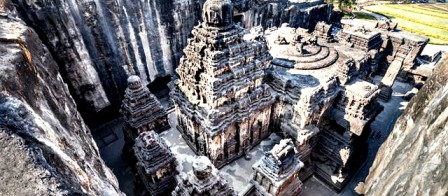Gupta Empire/Dynasty – History Study Notes & Stuff
Gupta Empire (319AD - 540AD)
The Gupta Empire arose in Magadha around 4th century AD and covered large part of the Northern India (though their empire was not as large as the Mauryas) and their rule lasted for more than 200 years.
The Gupta period is referred as the Classical Age or Golden Age of Ancient India. The lifestyle and culture of the Gupta empire is known to us through the availability of various ancient texts, coins, inscriptions and scriptures etc. related to the Gupta era.
Sources for study of Gupta period:
There are usually three types of sources Literary Sources, Epigraphical Sources, Numismatic Sources.
Literary Sources
- Mudrarakshasa and Devichandraguptam, written by Visakhadatta, provide details about the rise of the Guptas.
- Fa Hien, a chinese pilgrim, visited india during during the reign of Chandragupta II and described what he saw in his travelogue 'fo -gu -oji'.
Epigraphical Source:
- Mehrauli Iron Pillar Inscription - Chandragupta II's achievements
- Allahabad stone Pillar inscription – Describes his personality and achievement, regarding Samudragupta's reign. It is engraved on the Ashokan pillar, composed of 33 lines written by Harisena, written in Sanskrit in the Nagari script.
Numismatic Sources:
- Gupta kings issued coins have legends and figures.
- These gold coins give information about the sacrifices and titles taken by the Guptas.
The Gupta Dynasty :
Gupta empire, the founder of the dynasty was a person named Sri Gupta. He used the title of Maharaja. He was then succeeded by his son Ghatotkacha, who also inherited the title of Maharaja. More information about the rule of these two Maharajas is not available. Subsequently, important rulers of the Gupta dynasty ruled during this period.
Chandragupta I : 319-334 AD
- Chandragupta was a powerful Gupta ruler who fought many battles to obtain the title of Maharajadhiraja.
- His married to Licchavi princess Kumaradevi brought with him great power, resources and prestige. After that he took advantage of the situation and occupied the entire fertile gangetic valley.
- He is also known as the founder of the Gupta era. (319-20 AD).
- chandragupta I was able to establish his authority over magadha, Saketa and Prayaga.
Samudragupta : 330-380 AD
- Samudragupta was the greatest of the kings of Gupta dynasty and he is also known as Indian Napoleon.
- The Allahabad pillar inscription details his military victory in stages: - Samudragupta's Dakshinapatha campaign against South India, against the rulers of North India.
- It is ironic that the military achievements are etched on the same pillar that bears the inscription of peace-loving Ashoka.
- He is also called the "restorer of Ashwamedha", this shows from the coins issued by him.
- His greatest achievement was the political unification of India into formidable power.
- According to the chinese writer Wang-Hiuen-Tse, the ruler of Sri Lanka, Meghvarman sought permission of Samudragupta to build a monastery for Buddhist pilgrims at Bodh Gaya.
- Samudragupta Titles :
KAVIRAJA - King of poets (prayaga prasasti)
PARAM BHAGAVAT
ASHVAMEDHA-PARAKRAMA – horse sacrifice (Coin)
VIKRAM – Prowess (Coin)
SARVA-RAJ-OCHCHETTA – Uprooter of all kings (Coin)
- He patronized poets and scholars such as Harisena, and therefore played a role in promoting Sanskrit literature, which is a characteristic of the Gupta dynasty.
- However, Samudragupta also patronist the great buddhist scholar Vasubandhu, But he was a Vaishnavite.
Chandragupta II "Vikramaditya" of Gupta Dynasty : 380-414 AD
- Chandragupta II is also known as Vikramaditya.
- He extended the limits of empire by conquest (Western India) and matrimonial alliances (with Nagas and Vakatakas). His capital city was Pataliputra.
- He got his daughter Prabhatigupta married to a Vakataka prince Rudrasena II, who ruled the strategic lands of the Deccan. This was later proved to be very useful for him as he moved towards his campaign against the Shaka rulers of Western India.
- Chandragupta II defeated the Shaka rulers who ruled the region for nearly 4 centuries and conquered western Malwa and Gujarat. This earned him the titles of 'Sakari' and 'Vikramaditya'.
- Ujjain then became the commercial capital of the state because the Gupta empire gained access to the Arabian sea and opened trade with the western countries.
- Fa-hien, the Chinese pilgrim, visited India in chandragupta's reign.
- There were poets like Kalidasa in the court of Chandragupta II and he also patronized art and literature.
Kumaragupta I : 415-455 AD
- Chandragupta II was succeeded by Kumaragupta I.
- Kumaragupta I was a worshipper of god Kartikeya.
- Kumaragupta I Titles:
MAHENDRADITYA, MAHENDRA SINH and ASHVAMEDHA MAHENDRAH (Coins)
- He founded the Nalanda Mahavihara (Nalanda University) which later developed into an international centre of learning.
Skandagupta : 455-467 AD
- Sakandagupta , the last great ruler of gupta dynasty.
- During his reign the Gupta empire was invaded by the Huns but he saved the empire and these invasion weakened the empire.
- Details about him are mentioned on the Bhitari Pillar inscription, assumption of the title ‘Vikramaditya’.
The Later Guptas:
After the death of Skandagupta, there were other rulers of the Gupta dynasty such as Purugupta, Narasimhagupta, Buddhagupta. None of these were able to save the empire from Huns attacks. Due to the rise of Malwa and the continued Hun invasion, the Gupta dynasty completely disappeared.
We hope that this short notes about the rulers of Gupta dynasty is useful for your quick revision of the Gupta period. If you want us to add any more details to this article, please do let us know in the comments below.












0 Comments